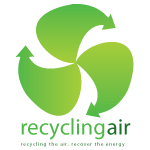.
Unsere Häuser sind komfortabler und energieeffizienter dank Fenster und Türen, die dicht schließen, aber paradoxerweise diese eine Bedrohung für unsere Gesundheit darstellen könnte, da Allergene und giftige Dämpfe, die aus Lacken, Kunststoffen, Beschichtungen, Klebstoffen und verschiedenen Haushaltsprodukten kommen, bleiben sie für lange Stunden in der Luft die wir atmen, um das Fehlen einer kontinuierlichen Luftaustausch.
Einer häuslichen verschmutzt Umgebung kann dazu führen Erkrankungen der Atemwege und verschlechtern erheblich die Symptome von Allergien, und vergessen Sie nicht die Bedeutung des Lebens in einer gut oxygenierten Umwelt.
Die Lösung, die sich bezahlt macht, ist eine Lüftung mit Energierückgewinnung installieren (ERV – Energy Recovery Ventilation) mit Filtern zur Feinstaub und Pollen ausgestattet.
How many threats in the indoor air?
As our homes become more energy efficient, paradoxically they become more hazardous to our health, because allergens and harmful indoor fumes from paint, plastics, carpets, adhesives, and household products stay trapped inside for long hours by the lack of continuous change of indoor air in our tightly sealed and well-insulated houses.
Polluted indoor air can cause respiratory irritation and worsen allergy symptoms for everyone inside, and let’s not forget the importance of living in a well-oxygenated house.
The solution is an energy recovery ventilation (ERV) with filters for fine dust and pollen.
.
An incomplete list of indoor air pollutants
Chemical Contaminants
- Scented fabric softener sheets transfer chemicals onto clothing and bed sheets.
- Dry-cleaned clothing can release chemicals into the air after they are brought into the home.
- Burning candles release soot and carbon monoxide into the air despite the common belief candles actually reduce rather than improve indoor air quality.
- Building materials like paints, adhesives, carpets and particle boards all contain chemical ingredients.
- Common household cleaners including bleach, disinfectant sprays, and ammonia-based cleaners release harmful fumes into the air when used.
- Plug-in scented oils and air fresheners can release chemicals into your home, and mask odours rather than improve air quality
- Hobby supplies such as paint and adhesives contain chemicals, sometimes toxic, that may or may not emit a strong odour.
- New furniture and draperies may be treated with anti-stain chemicals and or formaldehyde-based finishes that are released in the air for a period of time when new.
- Tobacco smoke contains many harmful chemicals, including formaldehyde.
- Radon a radioactive gas http://en.wikipedia.org/wiki/Radon: the “Radon is responsible for the majority of the public exposure to ionizing radiation. It is often the single largest contributor to an individual’s background radiation dose, and is the most variable from location to location. Radon gas from natural sources can accumulate in buildings, especially in confined areas such as attics, and basements”.
Biological Contaminants
- Plant pollen, abundant in spring and summer months, enters homes on shoes, clothing, hair, and pets.
- Dust mites produce droppings that are highly allergenic, and a prime cause of asthma attacks.
- Dander is produced constantly from cats and dogs. Pets constantly shed old skin cells (dander) which become airborne and, if not removed from the air, irritate the eyes and nose, or are inhaled into the lungs and cause allergic reactions and respiratory irritation.
- Mold and mildew grow in areas where moist air can’t escape, such as wall cavities and basements. Exposure to mold can cause allergic reactions and respiratory problems. Preventing mold is key to improving indoor air quality, and protecting your home investment, as mold can also cause structural damage to your home.
Source: www.livingbreathinghome.com
Bye for now and thank you for joining us on recyclingair.com .








 Klima Haus
Klima Haus LifeBreath
LifeBreath Mitsubishi electric
Mitsubishi electric Passivhaus Institut
Passivhaus Institut Rubner KlimaHaus
Rubner KlimaHaus sanuvox
sanuvox Amatrice – Club Alpino Italiano
Amatrice – Club Alpino Italiano Amatrice – Comune
Amatrice – Comune Amatrice – Parco Nazionale
Amatrice – Parco Nazionale amatrice.net
amatrice.net amatriciana.org
amatriciana.org Ausflüge
Ausflüge News
News

Leave a Reply
You must be logged in to post a comment.